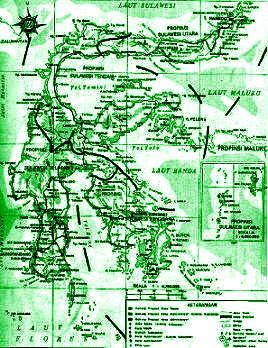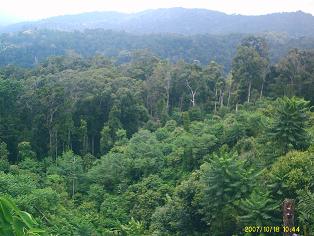
 |
|
|
|---|
| Much lower deforestation rates occur in Sulawesi than elsewhere in Indonesia, mainly because the Sulawesi lowland forests were cleared by the mid 1980s. Sulawesi is mainly a mountainous island with lowlands only occupying about 25% of the total area. By 1985, only a quarter of these lowlands still carried forest, with rapid clearing occurring in the transmigration areas. Further, Sulawesi has an impoverished assemblage of dipterocarp trees, which are the mainstay of forestry practices in the Sunda islands. For example its seven species of dipterocarp can be compared to 267 and 106 species found in Borneo and Sumatra, respectively (Ashton 1982). The main commercial timber trees in Sulawesi are the tall Agathis, the legume Podocarpus indicus, the gum tree Eucalyptus deglupta, Beremba (Duabanga mollucana) and Gutta Perca (Palaquium spp.). |
 |
|---|
Sandalwood (Santalum album) is almost extinct in Sulawesi. Holmes (2000) further stated that lowland forests are now essentially defunct as a viable resource in Sulawesi. Although, Sulawesi’s remarkable biodiversity and endemism are mainly found in the upland forests this should not preclude efforts to save the remaining lowland fauna and flora, particularly that in the coastal areas. Mangrove Forests along these coasts have been particularly hard hit by conversion. Between the mid 1980s and 1993, they decreased by 64% (84,833 ha to 152,567 ha). Despite the relative low rates of deforestation in Sulawesi compared to that found on the Sunda islands, Holmes (2000) showed that between 1985 and 1997 Sulawesi lost 20% of its natural forest cover.
This figure does not account for forest quality, or the fact that land classified as forests may contain logged or burned forest areas of reduced value for biodiversity conservation. While factors involved in deforestation are those reported earlier in this Report, an increasing threat are local migrants. Possibly as many as 200,000 people are moving into forested areas from urban areas of Sulawesi and from other islands. These migrants have converted vast amounts of forest to the high-value cash crops, coffee and cocoa (Whitten et al. 2002). |
|---|
Source : Report on Biodiversity and Tropical Forests in Indonesia, USAID/Indonesia, 2004. Prepared by : (1) Steve Rhee, M.E.Sc. (2) Darrell Kitchener, Ph.D. (3) Tim Brown, Ph.D. (4) Reed Merrill, M.Sc. (5) Russ Dilts, Ph.D. (6) Stacey Tighe, Ph.D. |
 |
 |
|---|
|
|||||||||||||||||||||||||||
|---|---|---|---|---|---|---|---|---|---|---|---|---|---|---|---|---|---|---|---|---|---|---|---|---|---|---|---|
|
|
|||||||||||||||||||||||||||